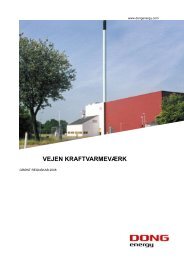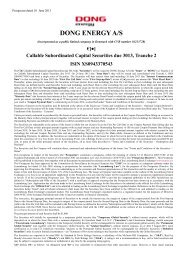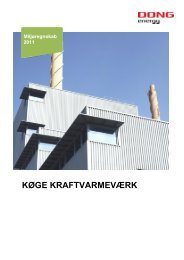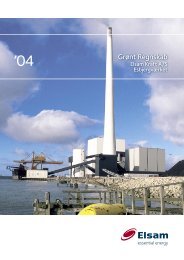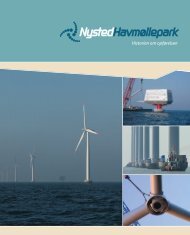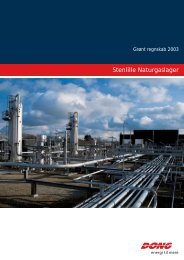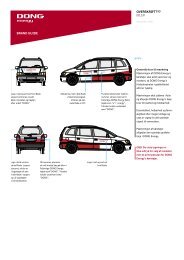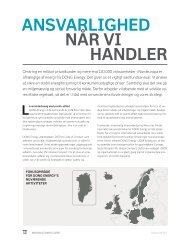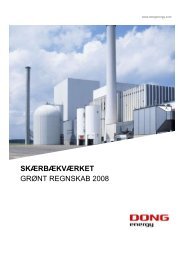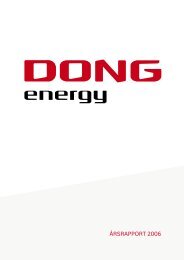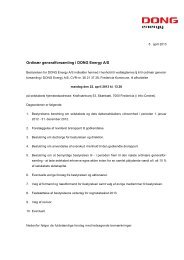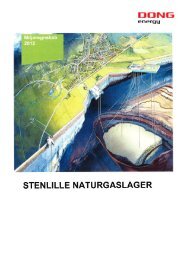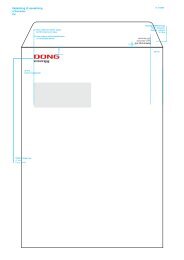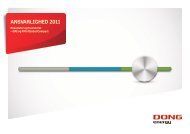ANNUAL REPORT 2011 - DONG Energy
ANNUAL REPORT 2011 - DONG Energy
ANNUAL REPORT 2011 - DONG Energy
You also want an ePaper? Increase the reach of your titles
YUMPU automatically turns print PDFs into web optimized ePapers that Google loves.
DKK million Goodwill<br />
Cost at 1 January 2010 663 3,163 597 827 144 5,394<br />
Foreign exchange adjustments 1 - 29 - - 30<br />
Adjustments relating to acquisition of enterprises (13) - - - - (13)<br />
Additions - - 384 6 131 521<br />
Disposals - (4) (187) (34) (7) (232)<br />
Transfers - 39 - 196 (235) 0<br />
Reclassifi cations - - (347) - (12) (359)<br />
Cost at 31 December 2010 651 3,198 476 995 21 5,341<br />
Amortisation and impairment losses<br />
at 1 January 2010 - (1,474) (186) (582) - (2,242)<br />
Foreign exchange adjustments - - - 1 - 1<br />
Amortisation, disposals - - 187 29 - 216<br />
Amortisation charge - (184) (202) (86) - (472)<br />
Impairment charge - - (93) - - (93)<br />
amortisation and impairment losses<br />
at 31 December 2010 0 (1,658) (294) (638) 0 (2,590)<br />
Carrying amount at 31 December 2010 651 1,540 182 357 21 2,751<br />
Impairment testing<br />
Goodwill and in-process development projects are tested for<br />
impairment annually. The carrying amounts of rights, CO2 emissions allowances and completed development projects<br />
are assessed annually to determine whether there is any indication<br />
of impairment. If any such indication exists, an impairment<br />
test is carried out.<br />
In an impairment test, the asset’s recoverable amount is<br />
compared with its carrying amount. An impairment loss is recognised<br />
whenever the carrying amount of an asset or its cashgenerating<br />
unit (CGU) exceeds its recoverable amount.<br />
The recoverable amount of an intangible asset is the higher<br />
of its fair value less expected disposal costs and the present<br />
value of the expected future net cash fl ows (value in use).<br />
Goodwill<br />
Testing for impairment is carried out for the business areas or<br />
activities that represent the lowest level of CGUs to which the<br />
carrying amount of goodwill can be allocated on a reasonable<br />
and consistent basis.<br />
Rights<br />
CO2 emissions<br />
allowances<br />
Completed development<br />
projects<br />
In-process development<br />
projects<br />
total<br />
Acquired enterprises are established either as new activities or<br />
are integrated as quickly as possible with existing activities to<br />
utilise potential synergies. For acquisitions that are not established<br />
as separate activities the implication of this is that, after<br />
a short time, it will no longer be possible to allocate the carrying<br />
amount of goodwill to the acquirees on a reasonable and<br />
consistent basis, and it will therefore no longer be possible to<br />
test goodwill from each acquisition for impairment.<br />
The recoverable amount of CGUs is determined as a value in<br />
use, where net cash fl ows are determined on the basis of business<br />
plans and budgets that have been approved by management.<br />
For some CGUs, value in use is determined on the basis<br />
of a defi nite period of years, while, for other CGUs, a terminal<br />
value after the budget period is determined based on the general<br />
growth outlook for the relevant markets. Net cash fl ows<br />
have been discounted using a discount rate before tax that<br />
refl ects the cost of capital associated with the activity.<br />
The goodwill allocation for each CGU and signifi cant assumptions<br />
applied in connection with the impairment tests carried<br />
out are set out below:<br />
<strong>DONG</strong> ENERGY <strong>DONG</strong> ENERGY GROUP <strong>ANNUAL</strong> <strong>REPORT</strong> <strong>2011</strong> – COnsOliDatED finanCial statEmEnts<br />
89 85<br />
notes



